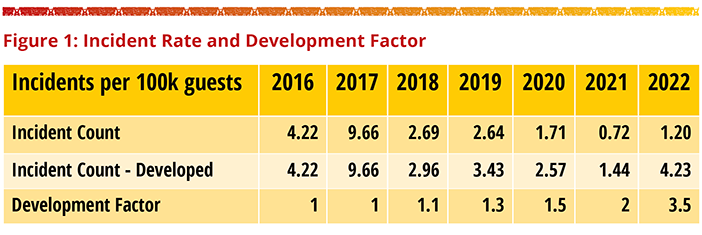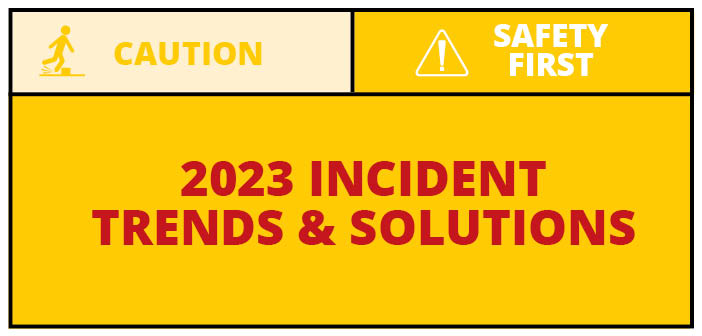Incidents happen. But what types, and how often? When measuring risk, and insurance premiums, these are critical questions to answer, as they directly affect insurance rates.
To understand the aerial adventure industry’s performance in risk management, Granite Insurance has led a data analysis study since 2019 that measures several critical data points within the zip line and aerial park community.
For example:
• How often does an incident occur?
• In what types of operations do they occur?
• What are the causations of these incidents?
• Where are we seeing trends getting better, or getting worse?
PARTICIPANT INJURIES: AN OVERVIEW
In 2022, injuries that led to insurance claims occurred to 4.23 participants per 100,000 guests. The data in Figures 1 and 2 show that this rate of claims is a substantial increase over 2021, and a moderate increase over the years 2018-2020.
Note that the numbers referenced for 2022 in this article are “developed.” We don’t yet know about all of the incidents that happened in 2022, since some claims will not be filed until one, two, or three years after the incident. Due to this delay, the final incident numbers are typically not fully “developed” until five years out.
To account for that delay, we use “development factors,” multipliers that help estimate what the eventual developed total will be. For example, we expect the number of incidents we know about for the calendar year 2022 on Dec. 31, 2022, to grow by 3.5 times, as more incidents are recorded over the next five years. The development factor reduces each year that we go back in time, as the “development,” or incidents that have not been reported, shrinks with each year that we go back.
A note about the increases and decreases in Figs. 1 and 2: There was a huge uptick in claims in 2017, which was the year mechanical braking devices first entered the market. There was a learning curve to this new technology. Operators were unsure of how to operate them, how to maintain them, etc., which led to a higher-than-normal incident rate. However, the incident rate decreased drastically in 2018 after operators became more familiar with using mechanical brakes, and continued to decrease through 2021.


Please note that the 2022 data are very green (new), and could develop much less than our predicted 3.5 times the current incident count; if so, the actual incident rate will be less than the predicted 4.23 injuries per 100,000 guests.
PARTICIPANT INJURIES: CAUSATIONS
When looking at incident trends, whether they are increasing or decreasing, the most important question is, “why?” Focusing on the causations of incidents, and where the claims are coming from, provides information you can use to prevent these incidents from becoming issues at your operation.
To help analyze the data, we compared 2022 to the average of the data from years 2016-2021. Several points and trends stand out:
• The industry is getting better about reducing injuries from the actual activities themselves (i.e., inherent risk). This category decreased from 36 percent of incidents during 2016-2021 to just 17 percent of the incidents in 2022.
• While we continue to improve in our areas of inherent risk, we continue to get worse in areas that are not central to our activities, especially passenger transportation and construction.
• The average claim amounts (dollars per claim) for every causation category, except operator error, increased. The increases are due to two main factors. 1) Zip lines and aerial parks are getting more extreme, and faster on average. When injuries occur going 40 mph vs. 7 mph, the injuries are more severe; and 2) litigation costs across the United States have increased significantly, along with inflation. From 2016 to 2020, the average cost of a claim (not industry specific) increased 300 percent.
• As an industry, we place great importance on the annual structural inspection. No doubt, this inspection is important, but structural and equipment failures account for a minuscule 1 percent of incident claims over the last six years.
• As an industry, we place less emphasis on operational reviews, even though operations (operator error, passenger transport, and construction/maintenance) accounted for nearly 60 percent of incidents in 2022. The data suggest that training and improved operating systems could reduce the number of operations-related
incidents.
• Passenger transportation incidents account for 52 percent of all claim dollars paid out, with an average claim amount of $146,250.

PARTICIPANT INJURIES: SOLUTIONS
We’ve talked about the trends, then causations, now let’s talk about the solutions to these trends. We’ll focus on three areas: passenger transportation, construction/maintenance, and operator error. These three areas increased the greatest in 2022 compared to 2016-2021 averages.
PASSENGER TRANSPORTATION
As an industry, we have standards and protocols for sending one person down a zip line. However, we have few if any standards around transporting six to 12 people up a winding, steep, gravel road in a van or UTV. Yet, the passenger transportation can be far riskier than the actual activity.
To provide ultimate control around the safety of your employees and guests in ATVs, UTVs, and vans, we recommend the following:
1. Have an approved driver list. Approved drivers should complete all of the following steps.
2. The employee must submit a motor vehicle report (MVR) and have it deemed acceptable. The MVR provides an overview of all traffic violations that an employee has had in the last 5 years.
3. Develop company driving rules and procedures for approved drivers to review and follow.
4. Vehicle training must be conducted with an experienced operator. This training should include:
a. overview of the vehicle and its different functions
b. a ride-along with the trainer, pointing out common blind spots and tips
c. review the driving rules and procedures (per step 3) with the employee
d. review, led by the trainer, of your operation’s expectations of the employee as a professional driver.
5. Daily vehicle checklist completed and documented.
6. Approved drivers should complete and pass both a written test and a practical (test drive) test.
These steps should be documented
internally for each approved driver, including the date(s) they completed each step. This documentation should be signed by the employee and the trainer.
Steps 1 through 6 should be repeated annually, for all drivers, and documented.
To see more about proper ATV, UTV or van safety, visit Granite’s resources page, graniteinsurance.com/wp-content/uploads/2022/07/ATV-UTV-and-Vehicle-Safety.pdf, or scan the QR code below:
CONSTRUCTION/MAINTENANCE
Incidents in the construction/maintenance of a course was not a noticeable category until 2022. This is not surprising, really; many courses are now getting to the point where they are 8-10+ years of age, where significant construction or maintenance needs to be done. In addition, more operators are conducting their own construction or maintenance in-house. This combination is leading to more construction- and maintenance-related injuries.
Examples of construction/maintenance incidents include guests proceeding down a section of the course that is under maintenance, and construction equipment passing underneath a line while a guest/employee is zipping, etc. Typically, the calls we get on these types of claims start with, “It was a perfect storm” or “it was a one-in-a-million chance of this happening.” The data suggest the chances are a lot higher than that, actually.
Because of the potential for injuries, we always recommend outsourcing construction and maintenance to a licensed and qualified professional.
Some steps you can take to reduce construction/maintenance incidents, whether you do the work in-house or outsource it:
1. Develop a checklist of all items to be completed when doing any maintenance or repair work.
2. Lockout and tag the area where construction and maintenance are being performed. This includes the actual course itself, and any area underneath. Barriers and signs should be placed on the ground. U-bolts should be placed on guy lines.
3. Install bright red signs that let participants and staff know the area/section of the course is closed due to maintenance/repairs.
4. Place signage in your employee check-in area so staff are aware of where maintenance or repairs may be occurring.
OPERATOR ERROR
These include incidents that occur during operations and are due to not following proper procedures, making an operational mistake, etc., and span a wide range, from improper braking techniques to improper communication (for example, failing to ensure that a zip line is clear for the next rider).
The main causation for operator errors is quite apparent: lack of experience/training for the role employees are performing. This is heightened by the current tight job market, when turnover is high and attracting talent can be difficult.
There are several steps you can take to reduce operator errors:
1. Conduct an operations review at your facility, by a third party. We recommend an ACCT certified Operational Review, but this could also be done by a vendor or another operator.
2. Develop and implement a guide development program. A guide that just graduated from 40 hours of training may not be ready yet to lead a tour of eight people, or operate as the receiving guide on a zip line. Create a program that allows the guide to start in a showing role, then a support role, and then graduate to a lead guide role. Make advancing to the next tier of the program a big deal. You can announce it on social media, during your internal team meeting, etc. Embrace constant development as part of your culture.
3. Make refresher training part of the program. Each month, pick a topic to review in your team meeting. The aim is to focus attention on a particular technical topic. Even better, ask one of your guides to present it. There is no better way to develop your learning than to prepare to teach others.
4. Document your training program. Development and training should not be checkbox-type items—they should be part of a continual progression for the entirety of an employee’s tenure with your company. Embrace the culture of constant team development. Make it a part of who you are.
ONWARD AND UPWARD
At Granite Insurance, we prepare this incident trends report annually because we truly care about the safety of the zip line and aerial park community. We want each of your operations to thrive and succeed. Thank you to each of our clients for empowering us with your partnership, so we can empower the industry with this data.
We encourage each of you to take 1 small action step based on this study. It’s not necessary to try and change the world all at once, but simply aim to be one percent better tomorrow than you are today.
Cameron Annas is the national practice leader for the Adventure & Entertainment group at Granite Insurance. He has served the zip line and aerial park community since 2014. [email protected].






